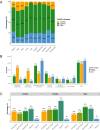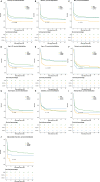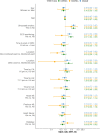Cohort study of the characteristics and outcomes in patients with COVID-19 and in-hospital cardiac arrest
- PMID: 34848525
- PMCID: PMC8635887
- DOI: 10.1136/bmjopen-2021-054943
Cohort study of the characteristics and outcomes in patients with COVID-19 and in-hospital cardiac arrest
Abstract
Objective: We studied characteristics, survival, causes of cardiac arrest, conditions preceding cardiac arrest, predictors of survival and trends in the prevalence of COVID-19 among in-hospital cardiac arrest (IHCA) cases.
Design and setting: Registry-based observational study.
Participants: We studied all cases (≥18 years of age) of IHCA receiving cardiopulmonary resuscitation in the Swedish Registry for Cardiopulmonary Resuscitation during 15 March 2020 to 31 December 2020. A total of 1613 patients were included and divided into the following groups: ongoing infection (COVID-19+; n=182), no infection (COVID-19-; n=1062) and unknown/not assessed (n=369).
Main outcomes and measures: We studied monthly trends in proportions of COVID-19 associated IHCAs, causes of IHCA in relation to COVID-19 status, clinical conditions preceding the cardiac arrest and predictors of survival.
Results: The rate of COVID-19+ patients suffering an IHCA increased to 23% during the first pandemic wave (April), then abated to 3% in July, and then increased to 19% during the second wave (December). Among COVID-19+ cases, 43% had respiratory insufficiency or infection as the underlying cause of the cardiac arrest, compared with 18% among COVID-19- cases. The most common clinical sign preceding cardiac arrest was hypoxia (57%) among COVID-19+ cases. OR for 30-day survival for COVID-19+ cases was 0.50 (95% CI 0.33 to 0.76), compared with COVID-19- cases.
Conclusion: During pandemic peaks, up to one-fourth of all IHCAs are complicated by COVID-19, and these patients have halved chance of survival, with women displaying the worst outcomes.
Keywords: COVID-19; adult cardiology; cardiology; coronary heart disease.
© Author(s) (or their employer(s)) 2021. Re-use permitted under CC BY-NC. No commercial re-use. See rights and permissions. Published by BMJ.
Conflict of interest statement
Competing interests: None declared.
Figures




References
-
- Johns Hopkins coronavirus resource centre . Johns Hopkins University and Medicine COVID-19 map [internet], 2020. Available: https://coronavirus.jhu.edu/map.html [Accessed 13 May 2021].
-
- Dödsorsaker första halvåret 2020, 2020. Socialstyrelsen. Available: https://www.socialstyrelsen.se/globalassets/sharepoint-dokument/artikelk... [Accessed 17 Nov 2020].
-
- Andersson J. Samhällsspridning AV coronaviruset I Sverige, 2020. Available: https://lakartidningen.se/aktuellt/nyheter/2020/03/samhallsspridning-av-...
Publication types
MeSH terms
LinkOut - more resources
Full Text Sources
Medical
Miscellaneous
